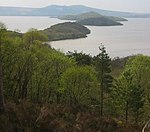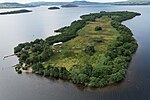Aber Isle
Islands of Loch LomondLoch Lomond National Nature ReserveScotland geography stubsUninhabited islands of Stirling (council area)

Aber Isle or Aber Inch is a small island in Loch Lomond, in west central Scotland. It is near the mouth of the River Endrick, by the abandoned village of Aber, and is 1⁄2 mile (800 metres) from Clairinch. Its name derives from the Celtic word for the mouth of a river, or Gaelic eabar meaning "mud, mire".There are some trees on it including alders and a collection of Scots pine and Hornbeam. It is owned as part of Claddoch, north of Gartocharn.
Excerpt from the Wikipedia article Aber Isle (License: CC BY-SA 3.0, Authors, Images).Aber Isle
Geographical coordinates (GPS) Address Nearby Places Show on map
Geographical coordinates (GPS)
| Latitude | Longitude |
|---|---|
| N 56.066666666667 ° | E -4.5333333333333 ° |
Address
Gartocharn
G83 8RX
Scotland, United Kingdom
Open on Google Maps









